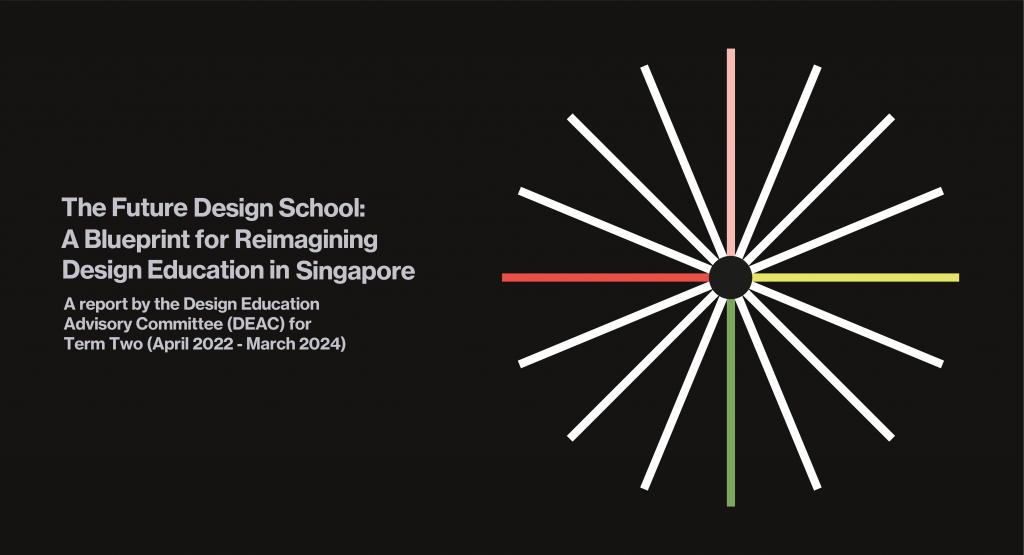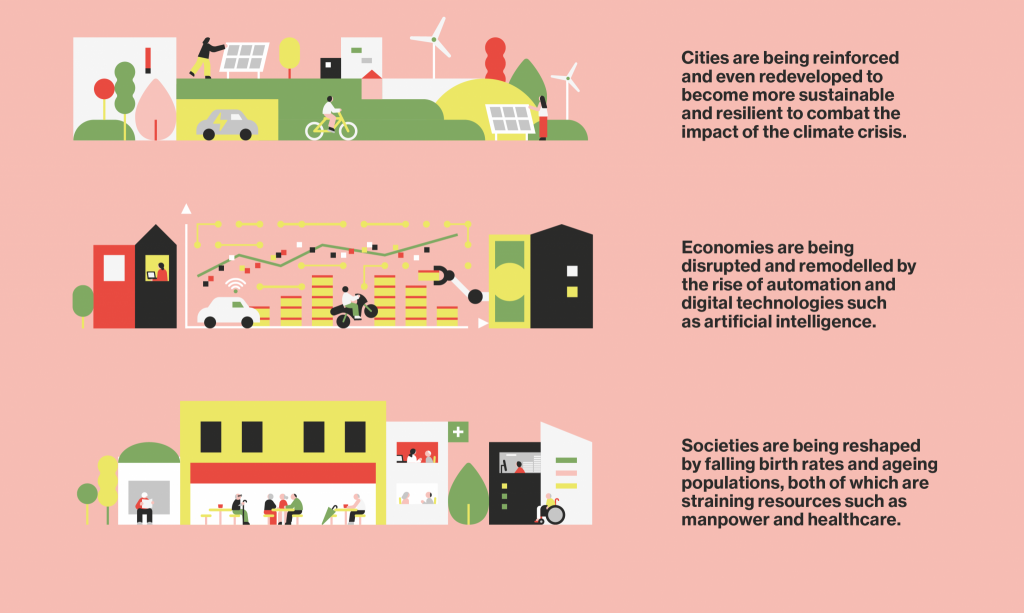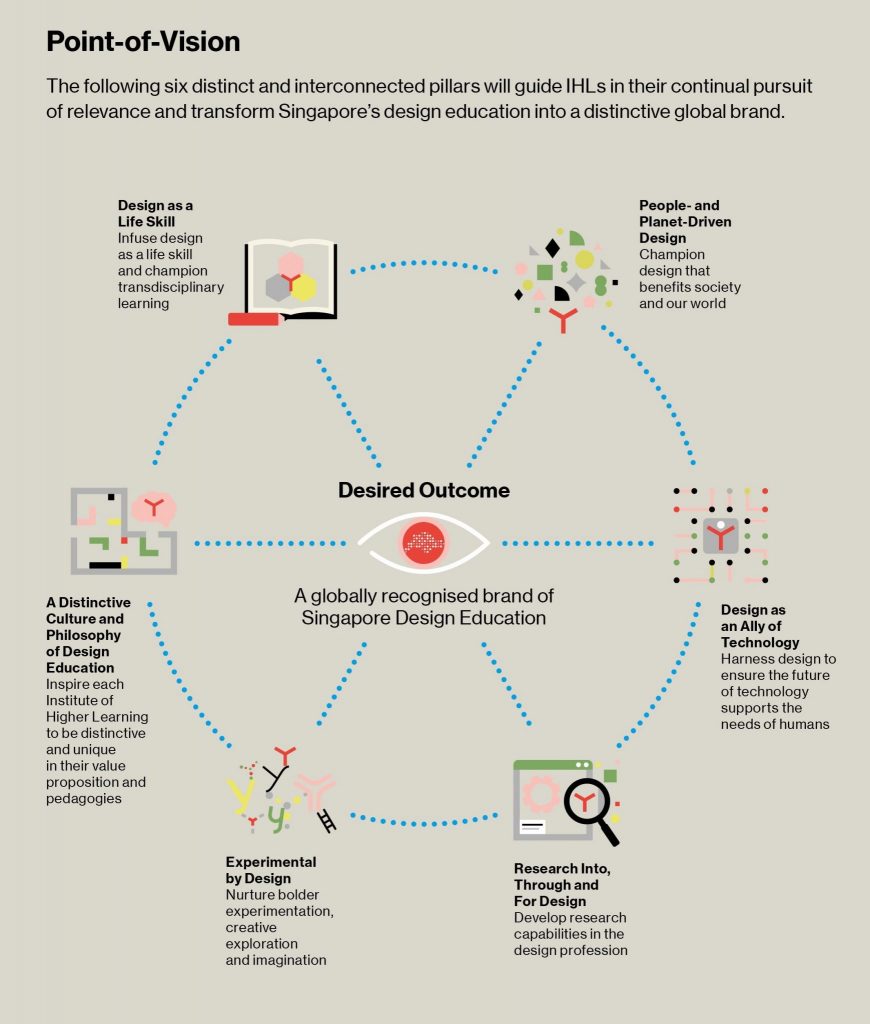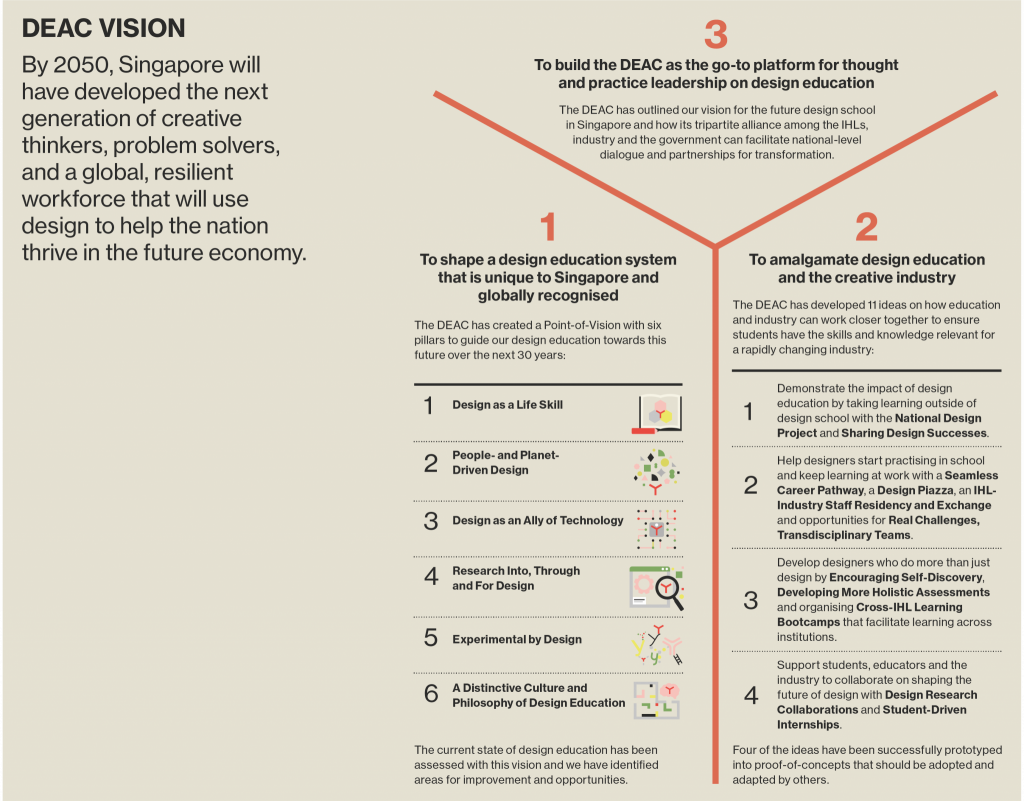
Design Education Advisory Committee (DEAC), Singapore’s first national-level design education committee, on June 12, 2024, put forth a blueprint to reimagine the future of learning in Singapore.
The committee, launched by the DesignSingapore Council (Dsg) and appointed by the Ministry of Trade and Industry (MTI), recommended a Future Design School as part of its second term report publication. This is a strategic initiative focused on building a more resilient and adaptable talent pipeline for Singapore.
With global economies shifting and cities facing increasingly complex issues like the effects of climate change, resource scarcity, ageing populations, and the unstoppable rise of automation and Artificial Intelligence (AI), Singapore needs to take a proactive approach to strengthen innovation and creative problem-solving capabilities in the next generation.
The blueprint recognises the critical role of design skills, alongside interdisciplinary learning and transdisciplinary practice, to give our youths the strong foundation needed. In this future education setup, learning through design is ubiquitous; it is part of everyday curriculum in schools.
 At the higher education level, all students are part of ‘One Design School’, conceptualised as a network of different Institutes of Higher Learning (IHLs) offering distinct courses and cultures that play to their respective qualities, strength and heritage.
At the higher education level, all students are part of ‘One Design School’, conceptualised as a network of different Institutes of Higher Learning (IHLs) offering distinct courses and cultures that play to their respective qualities, strength and heritage.
This network is further boosted by a dynamic collaboration between design practitioners and industry stakeholders to prepare students to drive real-world impact.
“Our North Star is to nurture Singapore’s next generation of creative thinkers and problem solvers with the skills and capabilities to tackle complex global challenges and opportunities in three key ways: innovating for businesses and social needs, creating solutions that benefit people and the planet and applying Singapore’s unique problem-solving design philosophy to drive progress for our country and regionally. We need to make learning through design core and accessible across the entire continuum of education and eventually elevate our workforce within the value chain and contribute to the growth of an innovation-led economy in Singapore,” says Mr Low Cheaw Hwei, chairman of DEAC.
In addition to outlining The Future Design School, the second term report expands on DEAC’s three recommendations1 for Singapore’s design education, which were formulated in the first term two years ago.
They are to 1) shape a design education system that is globally recognised yet unique to Singapore; 2) amalgamate design education and the wider industry; and 3) build DEAC as the go-to platform for thought and practice leadership on design education.
As part of the second recommendation, DEAC members invested over S$1,000,000, including 3,000 hours, to develop and test different prototypes from 2022 to 2024.
This resulted in four successful proof-of-concepts that demonstrate innovative approaches to teaching and learning while closing current gaps in design education.
The four proof-of-concepts:
- National Design Project to demonstrate the impact of design education: Taking design education outside of design schools, this initiative involved more than 200 students from over 30 schools. Organised by Temasek Polytechnic, it showcased how students from as young as primary school to those in pre-university institutions can use design to tackle everyday and complex issues. Chief Executive Officer of DP Architects, Ar Seah Chee Huang, served as the advisor while Creative Director of creative agency, Kinetic Singapore, Mr Pann Lim, was the curator and judge. The students’ works were presented to the Minister for Education, Mr Chan Chun Sing, last November. With the success of the National Design Project in 2023, there are plans to hold a second run in 2025.
- Seamless Career Pathway to blend education and industry work for greater relevance: Spearheaded by Nanyang Polytechnic and creative agency DDB Group Singapore, this first of its kind paid work-study arrangement for final year students helped selected students to work while still in school. The one-year arrangement not only eases the barriers between school and work environments to help students advance into the industry, it enables students to have a clearer idea of their career prospects through the exposure gained. The Seamless Career Pathway continues to grow with the addition of experience solutions company, Kingsmen, as a new partner.
- Cross-IHL Learning Bootcamp to spark new interests and capabilities beyond design: To help students learn beyond the formal curriculum and across institutions, this immersive bootcamp gathered design and non-design students and staff across IHLs to collaborate with organisations on real-world projects to develop design thinking and soft skills such as communication, entrepreneurship and negotiation. The bootcamp saw more than 120 students over two editions in 2022 and 2023. The committee will be expanding its outreach efforts to engage more participants in the next edition.
- Design Research Collaborations to spur innovation and wider applications: This collaborative learning model and platform was done through the inaugural IMPACT 2023 X Design Research Forum where 17 researchers across 13 design institutions in Singapore spoke to participants about topics such as Innovation, Sustainability and Entrepreneurship; and Culture; Society and Environment. A panel discussion was also organised to help educators better understand how design research can be used in practice. The IHLs involved are keen to drive greater knowledge-sharing by organising more of such events or creating a dynamic platform to make its findings accessible for all.
“ The Council has been a steadfast supporter of DEAC since its inception. We are proud to have contributed to building this eco-system and the development of these prototypes in the last two years to transform design education. The Future Design School proposed by DEAC is a bold vision that reimagines the future of learning. As Singapore journeys towards becoming an innovation-driven nation, empowering our next generation with design thinking as a national skillset will be instrumental in securing our future success,” says Ms Dawn Lim, Executive Director, DesignSingapore Council.
The Council has been a steadfast supporter of DEAC since its inception. We are proud to have contributed to building this eco-system and the development of these prototypes in the last two years to transform design education. The Future Design School proposed by DEAC is a bold vision that reimagines the future of learning. As Singapore journeys towards becoming an innovation-driven nation, empowering our next generation with design thinking as a national skillset will be instrumental in securing our future success,” says Ms Dawn Lim, Executive Director, DesignSingapore Council.
The second term report publication reiterates how the current design education system must remain relevant into the future. Central to this is DEAC’s Point-of-Vision, a roadmap to be realised by 2050, comprising six distinct and interconnected pillars:
i) People- and Planet-Driven Design
ii) Design as an Ally of Technology
iii) Design as a Life Skill
iv) Research Into, Through and For Design
v) A Distinctive Culture and Philosophy of Design Education
vi) Experimental by Design
To understand the overall landscape, policymakers and educators can refer to the publication’s overview of courses offered by 14 IHLs, aligned with the six pillars.
The report further highlights how IHLs have actively and independently implemented initiatives that tie back to the Point-of-Vision. The most recent is Temasek Polytechnic’s Interactive Digital Experiments with AI Studio (IDEAS) which opened in January 2024.
Showcasing the symbiotic relationship between design and technology, the polytechnic established this Centre of Excellence for students to have access to generative AI tools and software.
 “Developing a design curriculum that is robust and relevant is crucial so that our graduates are well- equipped to make positive strides in the industry. This is why we engage with and seek guidance from industry leaders, DEAC members, as well as other industry organisations to stay informed about trends and industry demands. For instance, the first DEAC Report in 2022 highlighted the importance of accelerating digital transformation. This played a key role in shaping our decision to embrace Generative AI within the curriculum and establish a dedicated space – IDEAS – for exploration and experimentation by students and faculty,” says Ms Elaine Ho, Director, School of Design, Temasek Polytechnic.
“Developing a design curriculum that is robust and relevant is crucial so that our graduates are well- equipped to make positive strides in the industry. This is why we engage with and seek guidance from industry leaders, DEAC members, as well as other industry organisations to stay informed about trends and industry demands. For instance, the first DEAC Report in 2022 highlighted the importance of accelerating digital transformation. This played a key role in shaping our decision to embrace Generative AI within the curriculum and establish a dedicated space – IDEAS – for exploration and experimentation by students and faculty,” says Ms Elaine Ho, Director, School of Design, Temasek Polytechnic.
Singapore’s Future Design School: A Collaborative Effort
Guided by DEAC’s Point-of-Vision and the Future Design School blueprint, the committee continues to pave the way for a transformative design education.
It applauds IHLs for their progress with courses that subscribe to the six pillars, especially in recent years, and urges them to sharpen their focus and deepen student engagement through new collaborations.
To keep the momentum going, DEAC will be working to bring in more participants from the industry and new stakeholder groups such as student leaders while forging stronger connections with policymakers.
It aims to foster robust partnerships and unite key stakeholders along with practitioners, parents, and supporters in a collective effort to contribute towards the Future Design School.
“The DEAC has made significant strides in shaping our design education system. We are nurturing a global and resilient workforce ready to use design to help Singapore thrive in the future economy. By building a robust design education system, we can nurture the next generation of creative thinkers to catalyse innovation and progress for our future,” says Ms Low Yen Ling, Senior Minister of State, Ministry of Culture, Community and Youth & Ministry of Trade and Industry.












